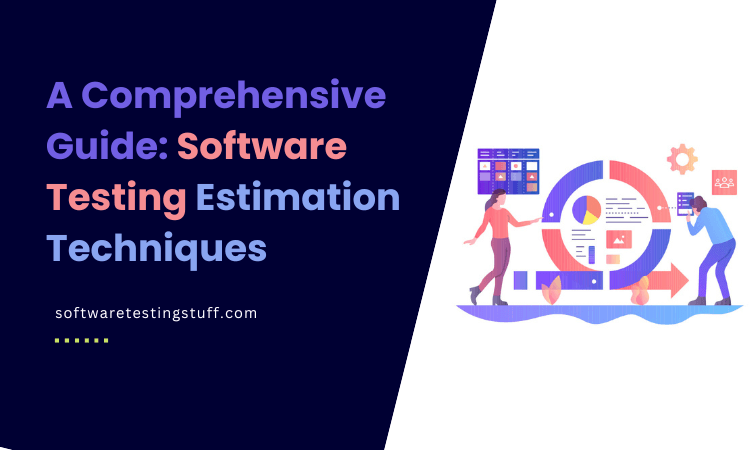Software development and testing are realms brimming with unpredictability. It’s through Software Testing Estimation Techniques that we bring a semblance of predictability and structure to the chaos.
As the digital landscape evolves, understanding these techniques becomes imperative. Their role isn’t just about prediction; it’s about ensuring a project’s success, effectiveness, and quality.
Dive into this article to uncover the depths and relevance of these estimation strategies in the software world. The future of seamless software hinges on them

- What is Software Test Estimation?
- Types of Software Test Estimation Techniques in Software Testing
- Why Software Test Estimation?
- What to Estimate?
- How to Estimate?
- Test Estimation Examples
- Software Test Estimation Rules
- Software Testing Estimation Techniques Best Practices
- Wrapping up
- Frequently Asked Questions
What is Software Test Estimation?
Software Test Estimation can be visualized as the act of predicting the time and resources that will be required to validate the quality of a software product effectively. It’s much like forecasting the weather; while you might not get it right down to the last detail, having a reasonably accurate prediction can guide preparations and plans.
With software, this ‘forecast’ aids teams in allocating resources, setting timelines, and managing stakeholder expectations.
Pro Software Test Estimation
They boast a whole of advantages which are —
Resource Allocation
With a clear estimation in hand, businesses can efficiently allocate their resources, be it human capital or technological tools. It prevents overstretching or under-utilizing assets.
Time Management
Time, in many ways, is the backbone of project management. Accurate estimations help in setting realistic deadlines, ensuring timely delivery without compromising on the quality of the software.
Stakeholder Confidence
When stakeholders have a clear picture of the testing phase, including its duration and resource needs, it fosters trust. They are reassured that the process is under control, and there’s a plan in place.
Budgeting
Financial planning becomes more streamlined when you have an accurate test estimation. It reduces the chances of unforeseen expenses cropping up in the middle of the testing phase.
Cons of Software Test Estimation
Like any other thing, test estimation has some drawbacks —
Inaccuracy Risks
Just like weather forecasts aren’t always spot-on, software test estimations can miss the mark. These inaccuracies can arise from unforeseen challenges, underestimations, or the sheer unpredictability of some software behaviors.
Potential for Scope Creep
If not kept in check, the testing phase can sometimes expand beyond the initial estimation, leading to what is termed as ‘scope creep.’ This can throw timelines and budgets off track.
Over-reliance
Teams might become too dependent on initial estimations and may resist adapting to real-time challenges or changes, believing they can stick rigidly to the forecasted plan.
Mismanaged Expectations
Any deviations from test estimations, especially those not factored into contingencies, can cause disappointment or friction between stakeholders and teams.

Types of Software Test Estimation Techniques in Software Testing
The digital universe is vast and ever-evolving. As software applications become more intricate, the need for thorough and efficient testing grows too. However, the question remains: how does one gauge the time and resources needed to ensure a piece of software meets the mark?
The answer lies in the domain of Software Testing Estimation Techniques.
In the vast expanse of software development, determining the scope and potential effort of the testing phase is no small feat. Hence, professionals rely on various software estimation techniques to form an educated guess on the required time, resources, and effort.
In addition to setting realistic expectations, these software testing techniques help align the goals and objectives of software testing with the project’s overall objectives.
Let’s dive into the primary techniques that shape the way software testing estimation is conducted:
Expert Judgment Estimation Technique
Sometimes, experience speaks louder than data. This technique involves experts who use their prior knowledge and expertise to make an informed estimation.
Experts often offer valuable insights based on past projects and understanding the nuances of current tasks that hard data cannot capture.
Use-Case Point Method
This technique revolves around the use cases of the software. By understanding the interactions of users with the system, estimators can better gauge the depth and breadth of testing required.
Complex interactions usually demand more testing effort, which can be calculated using a testing effort estimation formula based on use-case points.
Three-Point Estimation Test
Grounded in statistical methods, this technique involves three key scenarios: the best-case, most likely, and worst-case scenarios. An accurate estimation can be reached by examining challenges and ease of tasks in each scenario.
Work Breakdown Structure (WBS)
One of the more detailed software estimation techniques, WBS involves breaking down the testing project into smaller tasks. By understanding the time and resources each task demands, teams can piece together a comprehensive estimate.
Function Point Analysis
This method evaluates the software’s functionality and the user’s perspective. It categorizes functions into types and then weighs them based on complexity. Once this classification is done, a thorough analysis provides a structured estimation.
Parametric Estimation
Relying heavily on historical data, this technique uses parameters from previous projects to predict the current project’s requirements. It’s a method that becomes more accurate as teams gather more data over time.
Delphi Method
A consensus-driven approach, the Delphi technique gathers anonymous opinions from experts. After multiple rounds of review and refinement, consensus or near-consensus is reached, providing a well-rounded picture of the work to be done.
Ultimately, the importance of proper software testing estimation cannot be overstated. It serves as a roadmap, guiding the team’s direction and ensuring resources are used judiciously.

Why Software Test Estimation?
Why is this estimation so pivotal in ensuring that software stands tall amidst its competitors and functions seamlessly? You’re about to find out that below —
Resource Allocation
Effective software estimation techniques allow project managers to allocate appropriate resources, both in terms of personnel and equipment.
When you know how intensive the testing phase might be, it becomes easier to determine how many testers are needed or which tools will be essential.
Budget Management
Estimation aids in financial planning. By understanding the scope of testing, stakeholders can allocate budgets more efficiently, ensuring the project remains cost-effective without compromising on the quality of testing.
Time Management
It’s not just about how much testing is done; it’s also about when it’s done. Proper estimation provides a timeline, offering a clear indication of when each testing phase should commence and conclude.
This way, the entire software development process remains streamlined and on schedule.
Setting Client Expectations
With a clear testing effort estimation formula in hand, communicating the testing process to clients becomes transparent. Clients appreciate clarity, and by explaining the estimated time and effort, their expectations can be managed and met.
Risk Management
Uncertainty is a constant companion in software testing. However, with effective estimation, potential risks can be foreseen and mitigated. By predicting challenges and the required effort, teams can prepare for unforeseen events, ensuring smoother testing phases.
Prioritization
Some testing phases are more critical than others. Through precise estimation, project managers can prioritize tasks based on their complexity and importance.
This means that the most crucial elements of the software get tested first, ensuring a higher level of software reliability from early stages.
Boosted Morale
When teams have a clear roadmap, courtesy of apt software testing estimation techniques, they work with enhanced confidence. The clear direction and understanding of objectives lead to heightened morale and better team performance.
What to Estimate?
Embarking on the software testing journey necessitates a roadmap, and at its heart lies the Software Testing Estimation Techniques. But what aspects should be your focal point?
- Firstly, diving into software estimation techniques, it’s essential to gauge the depth of testing required. This means understanding the number of test cases and scenarios to cover.
- Secondly, leverage the testing effort estimation formula to anticipate the time and resources you’ll dedicate to each test phase.
In essence, estimating is not just about quantity, but about the quality and intensity of the testing process, ensuring that every software layer undergoes rigorous scrutiny.
How to Estimate?
Estimating software testing accurately and actionably requires a keen attention to detail as well as an understanding of the scope of the project.
However, when executed correctly, it can be the backbone of an efficient testing process.
Understanding the Software’s Depth
At the forefront of estimating lies a comprehensive grasp of the software’s intricacies. Deploy software estimation techniques to ascertain the size of the software, considering parameters like lines of code, modules, and features.
This gives a ballpark figure, shedding light on the amount of work to be undertaken
Incorporating Test Scenarios
Once the software size is defined, delve into the different test scenarios. Factor in the complexity and diversity of these scenarios to forecast the time and effort required.
Here, it’s beneficial to incorporate the testing effort estimation formula, tailoring it to each unique project. This formula can aid in allocating resources appropriately, ensuring no test case is overlooked due to a crunch.
Balancing Time and Resources
Balancing the available resources with the estimated time is pivotal. If a certain test requires specialist knowledge or tools, ensuring they’re available within the predicted timeline becomes paramount.
It’s here that the harmonious blend of time and resource allocation ensures efficient testing without overstretching boundaries.
Test Estimation Examples
Embarking on a journey through software testing? Grasping the nitty-gritty of estimation is crucial. Through real-world examples, we aim to shed light on the intricacies of test estimation, making the concept tangible and relatable.
Analyzing Software Size
Consider a new e-commerce app. Before jumping into testing, the team uses software estimation techniques to measure the app’s magnitude. They categorize features like product listings, cart functionalities, and payment gateways.
By understanding the software size, the team can then allocate resources and time more effectively.
Time Investment with Testing Scenarios
Imagine a security application with multiple modules. To ensure robustness, each module requires diverse testing scenarios. While a login module might need 10 hours of testing, a data encryption module could demand 25 hours.
Here, the testing effort estimation formula becomes invaluable. It helps in approximating the total time based on individual module complexities, thereby streamlining the entire testing process.
Resources and Specialized Testing Technique
Now, let’s picture a gaming application filled with intricate graphics and dynamic user interfaces. To test such an application, specialized tools and expertise are necessary.
Estimating this not only involves understanding the software’s breadth but also considering the availability of these specialized tools and skills.
Software Test Estimation Rules
Delving into software testing? One cannot emphasize enough the pivotal role that apt estimation plays. Proper rules and methodologies ensure precise evaluation, guiding teams towards an efficient testing process.
Understand Project Scope
Before any software estimation techniques come into play, grasp the entirety of the project. Recognize the depth and breadth of functionalities, user interactions, and expected outcomes.
This understanding forms the bedrock of any subsequent estimations.
Prioritize Tasks
Not all software components share equal significance. Categorize tasks based on urgency, complexity, and importance. This segregation helps to allocate more time to critical functionalities and streamline the overall process.
Use the Testing Effort Estimation Formula
A scientific approach often yields the best results. Leveraging a tried and tested formula provides a concrete structure to the estimation.
The testing effort estimation formula serves as a compass, guiding testers to allocate time and resources optimally.
Review and Revise
Estimations aren’t set in stone. As the testing phase progresses, unforeseen challenges might arise, or some areas might need more attention than initially thought.
Hence, it’s essential to periodically review and, if necessary, recalibrate the estimates.
Software Testing Estimation Techniques Best Practices
Diving into the realm of software testing, one quickly realizes the significance of accurate estimation. It’s not just about how long it’ll take, but also ensuring that the quality isn’t compromised.
To navigate these waters effectively, one must adhere to certain best practices in software testing estimation techniques.
In-depth Requirement Analysis
At the foundation of any software estimation technique lies a thorough understanding of project requirements. Before delving into estimates, teams must dissect the project’s needs, ensuring they have a clear picture of what’s ahead.
This clarity is instrumental in drafting an effective estimation.
Employ the Testing Effort Estimation Formula
Quantifying testing efforts can sometimes be like catching the wind in a net, elusive and tricky. This is where the testing effort estimation formula comes to the rescue.
Structured approaches are helpful in gauging resources, time, and manpower needed, ensuring accurate estimates.
Constant Collaboration of Estimation Techniques
Software testing isn’t a solo expedition. Collaborative efforts, where developers, testers, and stakeholders actively communicate, can lead to a more accurate estimation.
Feedback loops and shared insights can illuminate potential pitfalls and solutions, refining the estimation process.
Factor in Contingencies
Even with the most refined software estimation techniques, the unpredictable nature of software testing often throws a spanner in the works. Always factor in a buffer for unforeseen challenges, ensuring that these surprises don’t derail the entire testing process.
Continual Reviews
Estimations are not a one-off task. As the testing phase evolves, the landscape may shift. Regular reviews of the estimates, juxtaposed against the actual progress, help in keeping the process on track.
Adjustments, when made timely, can save resources and prevent overruns.
Wrapping up
Navigating the labyrinth of software development and testing is no mean feat. But, as we’ve explored, Software Testing Estimation Techniques provide clarity amidst this complexity.
Their value extends beyond mere prediction, acting as the backbone for efficient project management and delivery. Mastery of these techniques is tantamount to ensuring project success and setting the stage for a future where software solutions are not just built but crafted to perfection.
Frequently Asked Questions
How do Software Testing Estimation Techniques benefit a project?
They offer a predictive framework, ensuring efficient time management and resource allocation.
Why emphasize estimation in software testing?
Proper estimation leads to effective project timelines, optimized resources, and successful software deliveries.
Is it possible to bypass testing estimation?
Technically, yes. But it’s risky and might result in project delays, budget overruns, and subpar software quality.
- How to Convert PDF to Excel Easily (No Signup Needed) - April 13, 2025
- NameMesh Guide: Creative Business & Domain Name Generator - January 19, 2025
- Detailed Guide: Obtaining DNS Records for Your Domain - December 30, 2024
